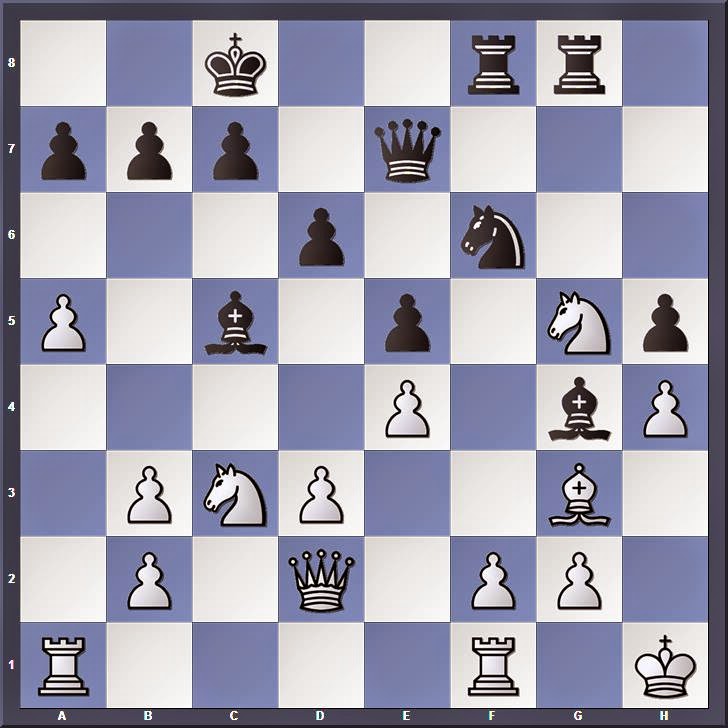I beat a National Master in a correspondence game!
This achievement might be an indication that my training methods are bearing fruit. I would like to think so, but there is evidence pointing to a more likely cause of this success. My opponent is playing too many games at once.
My draw with him finished on 30 March. Since that date, he has finished fifteen more correspondence games with 4 wins, 3 draws, and 8 losses. Perhaps he is treating these online correspondence games as an ongoing simul, playing at blitz speed in correspondence games. He has 63 more games in progress at the moment.
I was happy with the draw because it cut my game load to under one dozen. I discussed the consequences for my own play when I have more than twenty games in progress in "
Game Load: Turn-Based Chess" (January 2009).
I spent a lot of time on a few critical moves of this game. The opening was routine up to a point, then I used minimal guidance from databases to reach a promising middlegame. My opponent's predictable assault on my king led me to hunker down and spend some time looking at patterns in pawn storms. Then, during my counter-attack, my opponent's moves demonstrated that he was putting less effort into our game than I was.
Balakrishnan,P (2244) -- Stripes,J (2189) [C11]
TMCL 2014 Playoffs Division C - Board 3 Chess.com, 06.03.2015
1.e4 e6 2.d4 d5 3.Nc3 Nf6 4.e5 Nfd7 5.f4 c5 6.Nf3 Nc6 7.Be3 cxd4 8.Nxd4 Bc5
I have been in this position with Black at least five dozen times.
9.Qd2 0–0 10.0–0–0 a6 11.g4
A rare move that scores poorly for White. Even so, it seems consistent with White's general plan: a kingside assualt led by pawns. 11.h4 with the idea of Rh3 is popular. 11.Qf2 and 11.Nb3 have been popular among Grandmasters recently.
Black to move
11...Bxd4 12.Bxd4 b5 13.h4
13.g5? was played in a game that I looked at in
Chess Informant 44/345. 13...b4 14.Na4 a5 15.Be3 Qc7 16.Rg1 Ne7 17.Bb5! Rb8 18.Qe2 Bb7 19.Bd3? Rfc8 Hodgson,J (2510) -- Bareev,E (2555), Sochi 1987 (Black won in 44 moves).
13.Kb1 seems useful.
13...b4 14.Ne2 a5 15.g5
15.Ng3 Ba6 16.Bxa6 Rxa6 17.f5 Nxd4 18.Qxd4 Qc7 19.Rhe1 Rc6 20.Rd2 Rc4 21.Qe3 Rxg4 22.f6 Qxe5 23.Qxe5 Nxe5 24.fxg7 Rxg7 25.Nh5 Nf3 26.Nxg7 Nxe1 27.Nh5 Rc8 28.Kd1 Nf3 29.Rg2+ Kf8 30.Nf6 Ke7 31.Ng8+ Kd6 32.h5 Nh4 33.Rg1 Nf5 34.Kd2 h6 0–1 Okrugin,S (2365) -- Iljushin,A (2495), Tula 2001.
15...Ba6
15...a4 was the alternative. It was difficult to choose between these two. I finally decided a piece rather than a pawn should be moved even though both moves were almost certainly necessary. In what sequence remains a perplexing question to me. Moving the piece seems to offer more flexibility because there are two of White's minor pieces on the diagonal. An exchange will remain a possibility for at least two moves, and likely more.
16.h5 a4
So, now the other move.
17.g6!
Black to move
This move presented me a problem. I looked at a batch of French and Sicilian games with similar kingside pawn storms. Possible sacrifices on h6 were on my mind. Indeed, in my other game with this opponent, I made such a sacrifice, which led only to a draw.
17.Kb1 was played in the one reference game remaining in my database. Had we continued to follow this game, I hoped that I would be able to discover Black's critical errors and find improvements. 17...b3 18.cxb3 axb3 19.a3 Rc8 20.g6 fxg6 21.hxg6 h6 22.Bh3 Qe7 23.Nc3 Nxd4 24.Qxd4 Rc4 25.Nxd5 Qe8 26.Qa7 Nc5 27.Ne7+ Kh8 28.Bxe6 Nxe6 29.Qxa6 Rc7 30.Qxe6 Rxe7 31.Qg4 Qc6 32.f5 Qc2+ 33.Ka1 Rxe5 34.Rxh6+ gxh6 35.g7+ Kg8 36.gxf8R+ Kxf8 37.Qb4+ Kf7 38.Qb7+ Kf6 39.Qb6+ Kxf5 40.Rf1+ Ke4 41.Re1+ Kf5 42.Rf1+ Ke4 43.Qg6+ Kd5 44.Qf7+ Kc5 45.Qc7+ Kd5 46.Qf7+ Kc5 47.Qf8+ Kd5 48.Qxh6 Re2 49.Qg5+ Re5 50.Qd8+ Kc5 51.Qa5+ Kd4 52.Qb4+ Kd3 53.Qd6+ 1–0 Rivest,J (1925) -- Arsenault,N (2112), Montreal 2004.
17.h6 seems less dangerous. 17...g6.
17...fxg6
After using enough think time to prompt an email from
Chess.com that I was in danger of losing on time, I made my move. It seemed best to try to maintain the g-pawn for protection of my king.
17...f5 18.exf6 Nxf6 19.h6 looks bad for Black. Such a dynamic structure guarantees that Black's king will be exposed.
17...h6 opens possibilities for a piece sacrifice later.
18.hxg6 hxg6
The g-pawn is secure for now.
19.Qe3
19.Be3 b3 20.a3 Na5
19...b3
Now, it is Black's turn for an assault on the enemy monarch.
20.cxb3
Perhaps White can play 20.a3 because Black's dark-squared bishop was exchanged for a knight in the center.
20...axb3 21.a3
Black to move
21...Bxe2
Before playing this move, I worked out a fantasy checkmate that I knew would not occur in a game against a master. But, the vulnerability of the king on the c-file offered me enough counterplay that exchanging two sets of minor pieces seemed worthwhile. It also reduces White's future prospects against my king.
22.Bxe2 Nxd4 23.Rxd4?!
I expected 23.Qxd4 Qc7+ 24.Kd2 (24.Kb1? leads to my fantasy checkmate. 24...Qc2+ 25.Ka1 Rxa3+ 26.bxa3 Qa2#) 24...Qc2+ 25.Ke3
Analysis Position
 |
| After 25...Ke3 in the variation |
And now what? White's king in the center appears less vulnerable than my king hiding behind two doubled pawns. Black has an extra pawn, but White has a protected outside passed pawn.
23...Qc7+
Proceeding with my plan, which now seems better because b2 is not protected.
White to move
24.Kb1??
I was shocked when I saw that my opponent played this move.
I considered 24.Qc3 Qxc3+ 25.bxc3 Rxa3 when I have won a pawn in addition to the one my opponent sacrificed in the assault on my king.
24.Kd1 was also possible 24...Qc2+ 25.Ke1 Qxb2.
I was in Pizza Factory waiting for my lasagna when I saw my opponent's blunder on my iPhone. I replied instantly. This checkmate is elementary.
24...Qc2+ 25.Ka1 Rxa3+ 26.bxa3 Qa2# 0–1















































